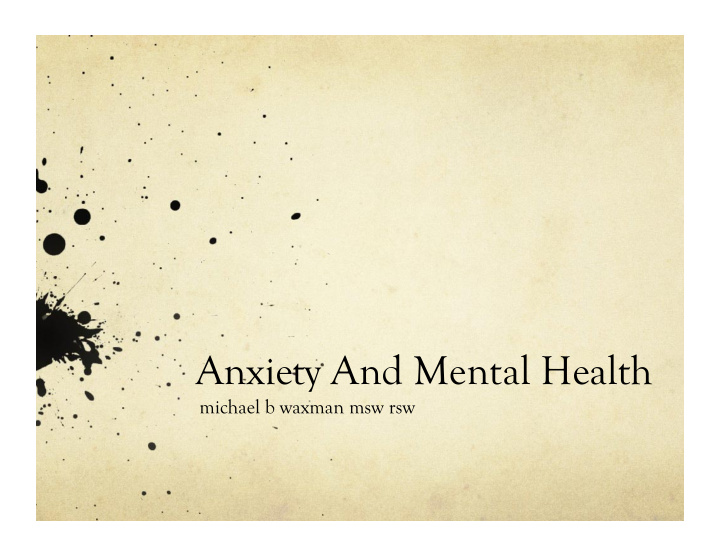



Anxiety And Mental Health michael b waxman msw rsw
What Do We Mean When We Talk About Mental Health?
Mental Health – Some Facts Mental illness affects 1 in 5 Canadians in their lifetime… *The remaining 4 will have a friend, family member or colleague who will struggle with mental illness Diagnosis is a professional and controlled act Mental Health problems are complex and overlapping Behaviours that you observe may be indicators of several different disorders, or of normal development
Mental Health – Why Now? Big societal emphasis on Mental Health Big emphasis on reducing the stigma related to mental health People have the courage to speak up about it Helping professionals are better equipped to deal with mental health issues Kids and Teens are better at communicating with each other and having difficult conversations
What Are Mental Health Concerns? They are a combination of emotional, behaviour and cognitive levels of functioning that cause distress or impairment in one or more areas of life i.e. school, work, friends, family interactions (www.kidsmentalhealth.ca)
What Are Mental Health Concerns?
What Is Anxiety? Mood Disorders Canada Intense and prolonged feelings of fear and distress that occur out of proportion to the actual threat or danger The feelings of fear and distress interfere with normal daily functioning Most common mental health problem during childhood and adolescence More girls than boys are affected Anxiety disorders are very treatable
How Does Mental Health Affect The Individual’s Family? Friends? Relationships? Sorrow Anxiety, Worry Fear Guilt Shame Feeling isolated Anger
Difference Between Anxiety And Fear Fear Reaction caused by actual threat of danger or harm Sensible response to something potentially harmful Necessary and useful to preserve life Anxiety Similar to fear but to events or things that are either not dangerous or are much less harmful than imagined Feelings come from the anticipation of danger or that something might happen
Protective Anxiety vs. Harmful Anxiety Protective Anxiety Thoughts, feelings, behaviours, and sensations associated with stressful life events Some anxiety is helpful because it keeps us cautious, safe and performing well Harmful Anxiety Exaggerated experience of these thoughts, feelings, behaviours and sensations and that interferes with functioning and/or causes distress (overestimate the threat, underestimate their ability to cope)
What Does Anxiety Look Like? Thoughts “Something bad might happen”, “I am not competent”, “I need to be perfect”, “What if..” Feelings Worry, tension, fear, unsettled Behaviours Avoidance of feared situations, perfectionism, procrastination, inertia, irritability Sensations Stomach aches, sweaty palms, shakiness, dizziness, racing heart, shortness of breath, muscle tension
Children And Youth With Anxiety May Present With: School problems (based on worry and anxiety) Attention difficulties Issues with attendance Recurrent physical symptoms Social and relational concerns Irritability and mood symptoms Alcohol and drug use Preoccupation with achievement
How To Determine If Anxiety Is A Problem Do other members of your family often miss out on desired events because one of your children is too anxious to participate? Does your child miss out on many potentially enriching and fun-filled events that they might enjoy because of anxiety? Does anxiety prevent your child from participating in an academic, athletic or extra-curricular activity? Does anxiety cause your child to not perform to their potential in an activity? Does your child spend excessive amounts of time arguing with you and trying to convince you to change plans, so that he can avoid something that should be fun or worthwhile? Do you feel that anxiety is determining too many of your child's decisions? How long have you felt this way? Have most children outgrown the anxiety by your child's current age
When Anxiety Becomes A Problem Functional Impairment A normal function is working at less than full capacity OR Subjective Distress The individual feels and expresses distress in their current environment
Anxiety Vs. Feeling Anxious It is possible to feel anxious without having anxiety It is not possible to have anxiety without feeling anxious Feeling anxious and being anxious are two different things
Common Types of Anxiety Disorders in Children and Youth Generalized Anxiety Disorder Excessive and chronic worry with physical symptoms Separation Anxiety Extreme worry about separation from loved ones Social Anxiety Disorder Extreme discomfort in social/unfamiliar situations Obsessive Compulsive Disorder (OCD) Intrusive and persistent thoughts and/or repetitive behaviours Specific Phobia Fear or avoidance of a specific object or situation Panic Disorder Unprovoked episodes of intense fear with physical symptoms Post Traumatic Stress Disorder (PTSD) Re-experiencing, hyper-vigilance after trauma
The Rest… School Anxiety Fear or avoidance of going to school, often started by missing many days or weeks in a row Test Anxiety Extreme worry or fear or writing a test or exam and/or reporting to “forget everything” when it comes time to take the test FOMO Anxiety Fear Of Missing Out Extreme fear or worry that one will “miss out” on a big plan, important conversation or inside joke by being away from social media or friend group
Treatment Medication Therapy Medication AND Therapy. Professional support is important. Early intervention can teach life long skills for managing anxiety.
michael b waxman mbwaxman@gmail.com or mwaxman@jfandcs.com www.michaelbwaxman.com facebook.com/mbwcounselling
Recommend
More recommend